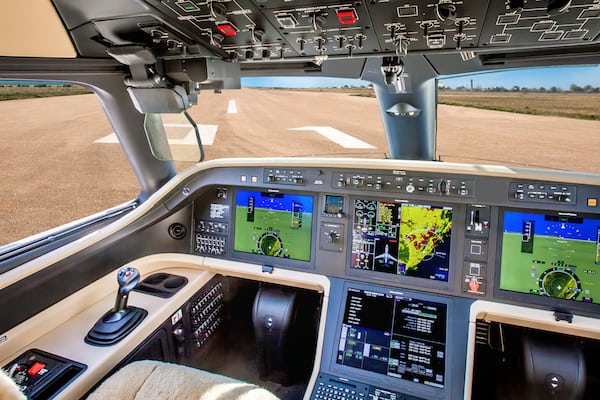
The Embraer Legacy 500 cockpit with waveguide HUD. (BusinessWire)
Pilots flying the Embraer Legacy 450 and 500 business jets are among the first to be using an augmented reality-based technology within their head-up displays (HUDs). The technology, waveguide optics, is designed by Silicon Valley-based DigiLens and now in production at Rockwell Collins on its HGS-3500 HUDs.
Waveguide optics, more commonly known as optical waveguide, is a physical medium that projects electromagnetic waves within the visible portion of the electromagnetic spectrum. On a HUD, it can guide information about airspeed, altitude, conformal flight path, energy trends and other critical flight data directly into the pilot’s line of sight. This enables the pilot to fly eyes forward in all phases of flight.
On the HGS-3500, there is an angled flat piece of glass located directly in front of the viewer that redirects the projected image in such a way as to see the field of view and the projected infinity image at the same time, according to Chris Pickett, CEO of DigiLens.
“The holographically printed diffractive patterns bend, shape, magnify and route the light, performing a range of optical functions in the thin waveguide that ordinarily would require complex and bulky refractive optics,” Pickett told Avionics.
While Embraer’s Legacy 450s and 500s are the first business jets to feature a certified waveguide HUD, it is not the industry’s only application of the capability within pilot display units.
A research team at the University of Arizona, for example, is working with Honeywell to develop HUDs that use holographic optical elements to redirect light from a small image into a piece of glass, where it is confined until it reaches another holographic optical element that extracts the light. The extraction hologram presents an image with a larger eye box size than the original image.
The research team believes the use of holography in place of conventional optics can reduce the need to increase the overall size of a HUD when trying to increase the size of an eye box or displayed image, according to an interview featuring The waveguide technology also allows for smaller optics due to the ability for the waveguide to expand the image over the design field of view.
BAE Systems’ LiteHUD, which pilots used for the first time in September 2017 on a U.S. Special Operations Command AC-130J aircraft, also uses optical waveguide technology. BAE describes it as a “see-through display.”
According to Rockwell Collins, the use of waveguide technology also allows size, weight and power (SWAP) reductions when compared to developing projection-style HUDs.
“The team worked over multiple years to develop the waveguide design that is optimized for integration into the HGS-3500. The waveguide technology allows for smaller optics due to the ability for the waveguide to expand the image over the design field of view,” a representative for Rockwell Collins said in an emailed statement, adding that the design process was not that much different than that of a traditional projection style HUD.